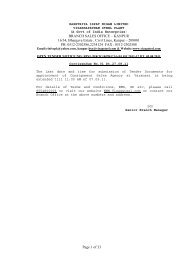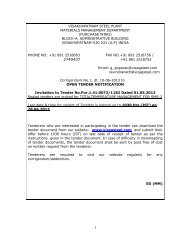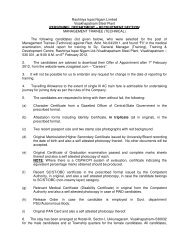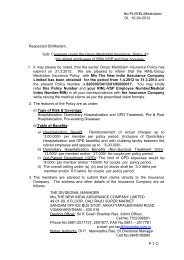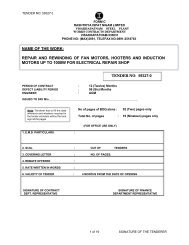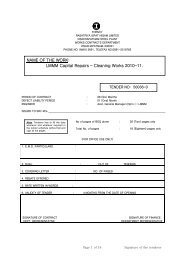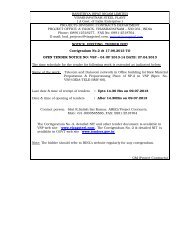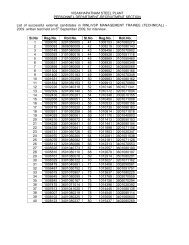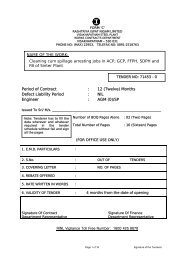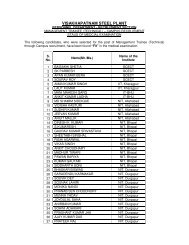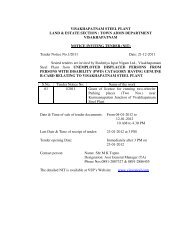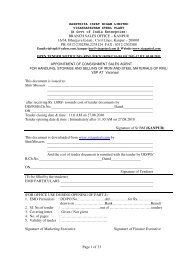Annual Report for 2011-2012 - Vizag Steel
Annual Report for 2011-2012 - Vizag Steel
Annual Report for 2011-2012 - Vizag Steel
- No tags were found...
You also want an ePaper? Increase the reach of your titles
YUMPU automatically turns print PDFs into web optimized ePapers that Google loves.
RASHTRIYA ISPAT NIGAM LIMITED<br />
ii.<br />
Increased bargaining power of raw material suppliers. Continuous expansion of the steel industry<br />
has resulted in a greater level of competition <strong>for</strong> raw materials, including iron ore and coal. Shortages of<br />
supplies in the market have allowed suppliers of iron ore and coal to restructure their pricing mechanisms,<br />
shifting from annual to shorter-term price contracts. These changes expose steel producers to additional<br />
volatility and price risk. While firmness in steel prices has given iron ore producers opportunities to increase<br />
prices in the contracts, steel companies do not always have the option to pass on such increase in input<br />
prices to end consumers due to the fragmented market. Thus, many leading steel companies are looking<br />
to pursue investments in mines as a safeguard measure against rising raw material costs. <strong>Steel</strong> producers<br />
have responded to these industry trends in past through vertical integration. Chinese steel producers are<br />
also consolidating to become major market participants.<br />
Despite recent consolidations, the global steel market continuous to be highly fragmented. According to<br />
the WSA, the five largest global steel producers in 2010 accounted <strong>for</strong> approximately 16.7% of total<br />
worldwide steel production, and the fifteen largest steel producers accounted <strong>for</strong> approximately 30.5%<br />
of total global steel production.<br />
iii. Shift to emerging markets. <strong>Steel</strong> production and trade have become increasingly globalised, with<br />
production shifting from mature to emerging economies. Developed countries have experienced increased<br />
costs associated with labour, freight and raw materials, which in turn have reduced the economic viability<br />
of basic steel production. In contrast, emerging markets, such as India, have become targets <strong>for</strong> global<br />
steel producers because of their relatively low steel penetration alongside relatively strong GDP growth<br />
outlook. Global steel producers are still looking to grow and are developing new capacity closer to the<br />
Chinese and Indian markets, including <strong>for</strong>ming joint ventures and setting up green field operations. Leading<br />
steel producers such as Arcelor Mittal, Nippon <strong>Steel</strong>, POSCO and Severstal are setting up, or have<br />
announced plans to set up, steel operations in India, either through joint ventures or independently.<br />
1.2.5. Global <strong>Steel</strong> Outlook:<br />
Despite a series of developments in <strong>2011</strong>, including the European sovereign debt crisis, earthquakes in<br />
Japan, the political/social unrest in some countries of the Middle East and North African (MENA) region<br />
leading to a related surge in oil prices and the tightening of government monetary measures in many<br />
emerging economies, world steel demand achieved a growth of 5.6% in <strong>2011</strong>.<br />
Apparent steel consumption in the United States is <strong>for</strong>ecast to rebound by 5.7% in <strong>2012</strong> and 5.6% in<br />
2013. Consumption in the EU27, however, is expected to decrease by 1.2% in <strong>2012</strong>, with a modest<br />
recovery of 3.3% in 2013, bringing it back to 77.0% of its 2007 level. Japan's demand <strong>for</strong> steel is expected<br />
to decline by 0.6% in <strong>2012</strong> due to the impact of exchange rate appreciation. In 2013, apparent steel<br />
consumption in Japan is expected to further decline by 2.2%, reaching 77.0% of its 2007 level. China, on<br />
the other hand, is expected to witness a continual growth of 4.0% in <strong>2012</strong> and 4.0% in 2013. India is<br />
also expected to increase its steel consumption by 6.9% in <strong>2012</strong> and 9.4% in 2013.<br />
Emerging economies are expected to continue to drive growth. By 2013, steel use in the emerging<br />
economies is <strong>for</strong>ecast to be 45.0% above 2007 levels, and will account <strong>for</strong> 73.0% of world steel demand;<br />
as opposed to 61.0% in 2007 (the above are as per WSA <strong>Report</strong>).<br />
1.3. The Indian Economic Environment :<br />
The Indian economy is one of the largest economies in the world, with a GDP at current prices estimated<br />
at US$1.7 trillion ( 52.8 trillion) <strong>for</strong> 2010, according to the World Bank. Its economy is better insulated<br />
from the global economy than several other Asian countries due to the fact that it does not rely heavily on<br />
40




